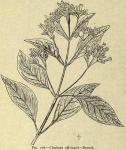 The dried bark of Cincho'na Ledgeriana Moens, Cincho'na calisa'ya Weddell, Cinchona officinalis Linné, and of hybrids of these with other species of Cinchona, yielding, when assayed, not less than 6 per cent. of cinchona alkaloids.
The dried bark of Cincho'na Ledgeriana Moens, Cincho'na calisa'ya Weddell, Cinchona officinalis Linné, and of hybrids of these with other species of Cinchona, yielding, when assayed, not less than 6 per cent. of cinchona alkaloids.
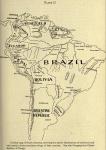 SOURCE VARIETIES, HISTORY, ETC.—The genus Cinchona is composed of over three dozen species, but few furnish the commercial barks. It is well known that the original source of the drug is South America (10° N. lat. to 19° S. lat., from about 3000 to 12,000 feet above sealevel), the area of the growth of the various species being confined exclusively to the Andes, chiefly on the eastern face of the Cordilleras—occasionally on the western face, which is covered by forests. The best known varieties from South America were the dark brown Loxa bark and the pale yellow-gray Huanuco. The cinchonas seldom form an entire forest, but rather groups interspersed among treeferns, gigantic climbers, bamboos, etc., sometimes growing separately in exposed situations, but under peculiar climatic conditions, such as a great humidity of atmosphere and a mean temperature of about 62°. Shade seems to favor the development of alkaloids. Dymock calls attention to the fact that "the north or shaded side of a tree has a richer bark than that on the south side," a fact which explains the success of the "mossing system." (There are four methods of collecting or harvesting the bark: (1) By taking it in longitudinal strips from the standing tree and leaving the bark to renew over the exposed wood; (2) by scraping and shaving off the bark; (3) by coppicing; and (4) by uprooting. The first is most in use . . . The trees are barked preferably in the rainy season, when the bark "lifts" or is more easily removed from the wood. The coolie inserts the point of a knife in the tree as far as he can reach and draws it down, making an incision in the bark straight to the ground; he then makes another cut parallel to the first, about an inch and a half distant and, loosening the bark with the back of the knife, the strip or ribbon is taken off. If the operation is performed carefully and the cambium cells are not broken, a new layer of bark will be formed in place of that which is taken away. The tree is then covered with moss, grass, or leaves, bound on by strings of fiber. All this is done to foster the growth of the new bark (renewed bark) from the cambium and to thicken the untouched layers of natural bark, which is now termed mossed bark.—Pharmacographia Indica.)
SOURCE VARIETIES, HISTORY, ETC.—The genus Cinchona is composed of over three dozen species, but few furnish the commercial barks. It is well known that the original source of the drug is South America (10° N. lat. to 19° S. lat., from about 3000 to 12,000 feet above sealevel), the area of the growth of the various species being confined exclusively to the Andes, chiefly on the eastern face of the Cordilleras—occasionally on the western face, which is covered by forests. The best known varieties from South America were the dark brown Loxa bark and the pale yellow-gray Huanuco. The cinchonas seldom form an entire forest, but rather groups interspersed among treeferns, gigantic climbers, bamboos, etc., sometimes growing separately in exposed situations, but under peculiar climatic conditions, such as a great humidity of atmosphere and a mean temperature of about 62°. Shade seems to favor the development of alkaloids. Dymock calls attention to the fact that "the north or shaded side of a tree has a richer bark than that on the south side," a fact which explains the success of the "mossing system." (There are four methods of collecting or harvesting the bark: (1) By taking it in longitudinal strips from the standing tree and leaving the bark to renew over the exposed wood; (2) by scraping and shaving off the bark; (3) by coppicing; and (4) by uprooting. The first is most in use . . . The trees are barked preferably in the rainy season, when the bark "lifts" or is more easily removed from the wood. The coolie inserts the point of a knife in the tree as far as he can reach and draws it down, making an incision in the bark straight to the ground; he then makes another cut parallel to the first, about an inch and a half distant and, loosening the bark with the back of the knife, the strip or ribbon is taken off. If the operation is performed carefully and the cambium cells are not broken, a new layer of bark will be formed in place of that which is taken away. The tree is then covered with moss, grass, or leaves, bound on by strings of fiber. All this is done to foster the growth of the new bark (renewed bark) from the cambium and to thicken the untouched layers of natural bark, which is now termed mossed bark.—Pharmacographia Indica.)
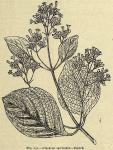 Cultivated trees in recent years have been the chief source of the commercial barks. To some extent the cultivation has been carried on in South America, but great success has attended the persevering efforts of the Dutch Government and the Government of British India. Extensive plantations of cinchona are now flourishing, to the extent of several million trees of the more important species, on the Neilgherry Hills and in the valleys of the Himalaya in British Sikkin. The tree is also cultivated in Ceylon, Java, Jamaica (Blue Mountains), and other countries.
Cultivated trees in recent years have been the chief source of the commercial barks. To some extent the cultivation has been carried on in South America, but great success has attended the persevering efforts of the Dutch Government and the Government of British India. Extensive plantations of cinchona are now flourishing, to the extent of several million trees of the more important species, on the Neilgherry Hills and in the valleys of the Himalaya in British Sikkin. The tree is also cultivated in Ceylon, Java, Jamaica (Blue Mountains), and other countries.
VARIETIES.—There are about twenty varieties of cinchona barks, and it is a very difficult matter to distinguish them, since they have been and are now changed so much by grafting and crossing. The varieties generally used and best known are: C. succirubra Pavon, C. calisaya Weddell, C. ledgeriana Moens, C. lancifolia Mutis, and C. officinalis Hooker.
The success of the Dutch planters of Java has been so pronounced that the greater portion of cinchona bark comes from this place, leading varieties being ledgeriana and succirubra bark. In Java great care is exercised in the cultivation. The trees are allowed to reach the age of twelve years before the bark is collected. The cultivation is largely confined to the variety Ledgeriana. Over 500,000 pounds are collected annually from Java plantations.
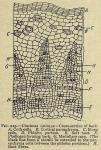
 DESCRIPTION.—In quills or curved pieces of variable size, usually 2 or 3, sometimes 5 mm. thick; externally gray, rarely brownish-gray, with numerous intersecting transverse and longitudinal fissures, having nearly vertical sides; the outer bark may be wanting, the color externally being then cinnamon brown; the inner surface light cinnamon brown, finely striate; fracture of the outer bark short and granular, of the inner finely splintery; powder light brown or yellowish-brown; odor slight, aromatic; taste bitter and somewhat astringent.
DESCRIPTION.—In quills or curved pieces of variable size, usually 2 or 3, sometimes 5 mm. thick; externally gray, rarely brownish-gray, with numerous intersecting transverse and longitudinal fissures, having nearly vertical sides; the outer bark may be wanting, the color externally being then cinnamon brown; the inner surface light cinnamon brown, finely striate; fracture of the outer bark short and granular, of the inner finely splintery; powder light brown or yellowish-brown; odor slight, aromatic; taste bitter and somewhat astringent.
 MICROSCOPICAL.—The calisaya (variety Micrantha) transversely shows milk-vessels in the cortical parenchyma and absence of stone cells, which are present in Lancifolia. The rays of the woody portion are more elongated and the medullary rays larger in size. Bast fibers comparatively small and less numerous, but are spindle-shaped, as they are in all true cinchona barks showing longitudinal section. In C. rubra the stone cells and milk-ducts are both wanting, while the bast fibers are more numerous and stouter. The bark is richer in coloring matter. In cuprea bark the cork cells are thicker and the cortical parenchyma cells smaller, stone cells present, milk-ducts absent, few bast fibers, but the woody portion contains indurated cells, which simulate them. The ligneous cells are very numerous and extend even down into the medulla. They are smaller than the bast fibers of true cinchona barks, but much more numerous.
MICROSCOPICAL.—The calisaya (variety Micrantha) transversely shows milk-vessels in the cortical parenchyma and absence of stone cells, which are present in Lancifolia. The rays of the woody portion are more elongated and the medullary rays larger in size. Bast fibers comparatively small and less numerous, but are spindle-shaped, as they are in all true cinchona barks showing longitudinal section. In C. rubra the stone cells and milk-ducts are both wanting, while the bast fibers are more numerous and stouter. The bark is richer in coloring matter. In cuprea bark the cork cells are thicker and the cortical parenchyma cells smaller, stone cells present, milk-ducts absent, few bast fibers, but the woody portion contains indurated cells, which simulate them. The ligneous cells are very numerous and extend even down into the medulla. They are smaller than the bast fibers of true cinchona barks, but much more numerous.
These barks are thoroughly saturated with pigments, principally cinchona red, the phlobaphen of all cinchona barks. Before microscopical examination these pigments must be removed by a weak alcoholic solution of ammonia. This requires considerable practice (Dohme). Compared with other barks, the fibers of the liber of cinchona are shorter and more loosely arranged, being for the most part separated into simple fibers imbedded in the bast parenchyma, or united into very short bundles.
Grahe's test for the distinction of cinchona bark is as follows: On heating about 0.1 Gm. (1 ½ gr.) of the powdered bark in a dry test-tube a tarry distillate of a red color is obtained.
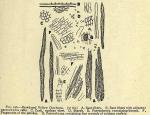 Powder.—Microscopical elements of: See Part iv, Chap. I, B.
Powder.—Microscopical elements of: See Part iv, Chap. I, B.
- OFFICIAL PREPARATIONS.
- Fl. Ext. Cinchonae, Dose: 15 drops (1 mil).
- Tr. Cinchonae , 1 fl. dr. (4 mils).
532a. CINCHONA RUBRA.—The dried bark of Cinchona Succirubra Pavon or its hybrids, yielding not less than 6 per cent. of the total alkaloids of Cinchona. "In quills or incurved pieces, varying in length, and from 2 to 4 or 5 mm (1/12 to ⅙ or ⅕ in.) thick; the outer surface covered with a grayish-brown cork, more or less rough from warts and longitudinal, warty ridges, and from few, mostly short and not frequently intersected transverse fissures, having their sides sloping; inner surface more or less deep reddish-brown and distinctly striate; fracture short, fibrous in the inner layer; outer layer, granular. For years practically all of the red cinchona bark, so called, was only a hybrid, but recently, and especially for a year past, fine quill bark of pure succirubra has frequently been received.
Powder.—Microscopical elements of: See Part iv, Chap. I, B.
CONSTITUENTS.—Upon quinine, C20H24N2O23H2O, the bark almost exclusively depends for its value. This alkaloid is colorless, amorphous, or in acicular crystals; inodorous, very bitter; soluble in 1670 parts water, 6 parts alcohol, 26 parts ether. Aqueous solutions of the salts have a blue fluorescence, and when treated with chlorine water and ammonia a beautiful green color is produced—"Thalleoquin test." The solutions deviate the plane of polarization to the left. The tartrate is soluble in water. A cold aqueous solution of the sulphate remains unaffected by potassium iodide T. S. (difference from quinidine). The other prominent principles are:
CINCHONIDINE, C19H22N2O—isomeric with cinchonine, non-fluorescent; forms colorless, anhydrous crystals, soluble in 20 parts alcohol (80 per cent.), 1680 of water, and 188 of ether. The sulphate is more soluble in water than quinine, and the tartrate very insoluble. The Thalleoquin test (see above) gives a white precipitate. Represented in Cinchonidinae Sulphas.
CINCHONINE, C20H24N2O—white lustrous prisms, soluble in 3760 parts water, 116 parts alcohol, and 526 parts ether; has exactly the opposite action to cinchonidine and quinine upon polarized light.
QUINIDINE, C20H24N2O2—isomeric with quinine; crystallizes in prisms soluble in 2000 parts water, 0.8 part alcohol, about 30 parts ether; turns the plane of polarization to the right. A cold aqueous solution of the sulphate yields a white precipitate with potassium iodide T. S. (difference from sulphate of quinine). Represented in Quinidinae Sulphas.
Among the unofficial alkaloids and principles found in the bark are the following: Isomeric with quinine and quinidine is quinicine; with cinchonine and cinchonidine, are cinchonicine, homocinchonine, homocinchonidine, homocinchonicine, and apoquinamine; a brown amorphous alkaloid is obtainable from the mother-liquor known as chinoidine (quinoidine), a mixture of various not well-defined alkaloidal substances; kinic acid, C7H12O6, and kinovic acid, kinovin; bitter cinchonic acid (derived from preceding); volatile oil, a minute quantity.
Separation of Total Alkaloids.—Moisten powdered cinchona with ammonia water and allow it to stand for an hour, then hot water is added. To the mixture, after cooling, milk of lime is added and the whole evaporated to dryness. This is placed in an extraction apparatus and exhausted with ether. Water acidulated with HCl is added to neutralize the alkaloids and the ether distilled off. The cooled liquid is filtered and decinormal solution of soda is added. Finally, sodium hydrate is added to complete the precipitation of the alkaloids. There are numerous other processes, but this seems a simple and satisfactory one to use for assay purposes.
YIELD OF ALKALOID.—The richest government bark brought to the market until recently has not exceeded 91/2 per cent. of sulphate of quinine; 7 to 8 per cent. is a good average in government plantations. Barks taken from the trees in the government gardens at Pioeng Goenoeg, Java, have recently been analyzed and found to equal respectively 12.66 and 16.04 per cent. of quinine sulphate.
ACTION AND USES.—The action of cinchona bark is due almost entirely to the alkaloids therein contained. Quinine is a powerful antiseptic, destructive, in weak solution, to infusorial and vegetable life. Internally it stimulates the muscular fibers of the stomach, acting as a bitter tonic, invigorating the vital functions and aiding digestion. In large doses the brain is affected, giving rise to symptoms such as fullness, frontal headache, deafness, ringing in the ears, and mental dullness. This effect is called "cinchonism" attributed to partial anaemia of the brain, contraction of blood-vessels, etc. Heart action is depressed. Reflex excitability of the spinal cord is lowered. In the blood, quinine arrests the migration of the white corpuscle and checks its amoeboid movement; the oxygen-carrying function of the red corpuscle is impaired; infectious micro-organisms in the blood and tissues are probably rendered inactive or destroyed. The toxic symptoms produced by quinine and allied salts are spoken of collectively as cinchonism, which ordinarily is not allowed to go further than tinnitus aurium.
Dose of cinchona: 15 to 60 gr. (1 to 4 Gm.), in powder, fluidextract, or its equivalent in the salts of the alkaloids.
- OFFICIAL PREPARATION.
- Tinctura Cinchonae Compositae (10 per cent., with bitter orange-peel 8 per cent., and serpentaria 2 per cent.) 1 to 4 fl. dr. (4 to 1.5 mils).

